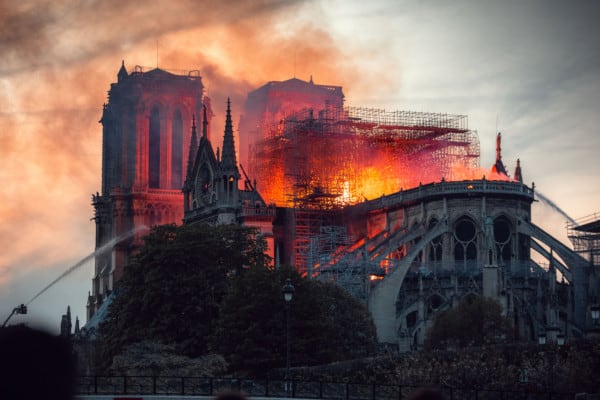The damage at Notre-Dame de Paris points to greater fire risks facing churches—especially those that double as historic structures
This weekend, a handful of priests and other attendees gathered in the remains of the Notre-Dame cathedral in Paris, France. The mass, broadcast live on French television, is the first service held in the cathedral since the devastating fire just two months prior. It marks a hopeful pause in the difficulties now facing Paris, as more than $1 billion may be needed for reconstruction. President Emmanuel Macron has made an ambitious pledge to restore the holy site in five years.
In this article, we look at the Notre-Dame cathedral, explaining what happened and what it means for the more widespread problem of fires in churches and other houses of worship.
The fire at Notre-Dame threatened more than just architecture
The blaze consumed the attention of onlookers worldwide and sparked pledges of more than $500 million from the world’s wealthiest people. The fire at the 800-year-old structure captured so much media attention because it has lived in Parisian life and imagination as a site of feasts, philosophy, religious and kingly power, architectural beauty, and local identity for centuries. This marvel of Gothic architecture took nearly 200 hundred years to build. And over the hundreds of years that followed, it was ravaged, rebuilt, expanded, and transformed into a cultural landmark.
But much of what makes Notre-Dame noteworthy is what was inside. The cathedral housed sacred artifacts and historic art, such as:
- The Holy Crown of Thorns, believed to date back to Christ’s crucifixion
- The Great Organ, one of the world’s largest organs and part of a musical tradition that can be credited with inspiring music from Beethoven to Beyoncé
- Stained glass windows along with centuries-old statues and religious paintings
- Emmanuel, a bell weighing 13 metric tons and rang only on rare occasions—including at the liberation of Paris in World War II
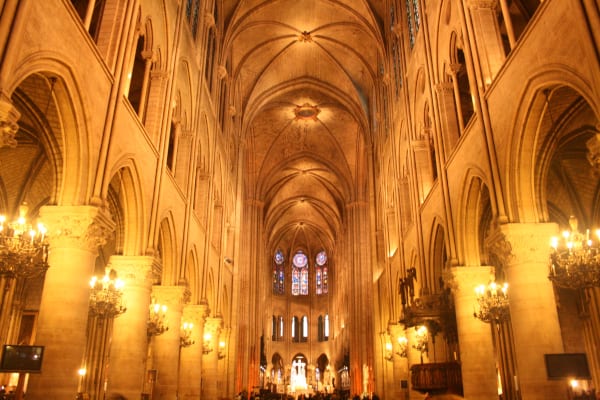
Investigators have identified likely catalysts for the fire, but poor fire protection measures allowed the blaze to spread
With towers standing 69 meters tall and a surface area of 4,800 square meters, the Notre-Dame Cathedral is a sizable building—although it’s far from the largest church in France. Walls of stone supported a roof made largely of lead-sheathed 13th-century oak, with vaulted ceilings and a single spire weighing 750 metric tons.
But problems plagued the cathedral even before the fire. Water had slowly eroded wood and stone throughout. In 2017, experts estimated that nearly $180 million would be needed to perform repairs.
At 6:20 PM on April 15, 2019, an alarm sounded at the cathedral. Less than half an hour later, fire broke out in the roof. The spire caught fire and fell through. French President Emmanuel Macron and onlookers watched as the flames spread, destroying more than two-thirds of the roof. More than 400 firefighters working for nine hours successfully saved much of the Cathedral’s structure while bringing artifacts to safety. Canada’s CBC news shared this video of the fire’s progression:
Investigators have focused on two possible causes of the fire: an electrical short circuit near the spire, or cigarettes on the scaffolding (from renovation workers). But the scale of the devastation could have been significantly less. Notre-Dame Cathedral lacked a fire sprinkler system and even the passive forms of fire protection now standard in modern buildings.
Without firewalls—walls manufactured and installed to resist the spread of fire—fire moved rapidly along the roof. Compounding these problems were serious delays in notifying the fire department. More than 30 minutes elapsed as guards walked between the remote locations where fire alarm control panels and other equipment were stored.
Houses of worship face unique fire safety challenges
Another sacred site caught fire on the same day as the Notre-Dame: the Al-Aqsa Mosque in Jerusalem, Israel. The mosque, which was established more than 1,300 years ago, joins Mecca and Medina as one of the most important sites for followers of Islam. The fire left the structure unharmed, damaging only a remote room used for prayer. But it’s easy to imagine things going far worse for the historic site, which often houses thousands of people.
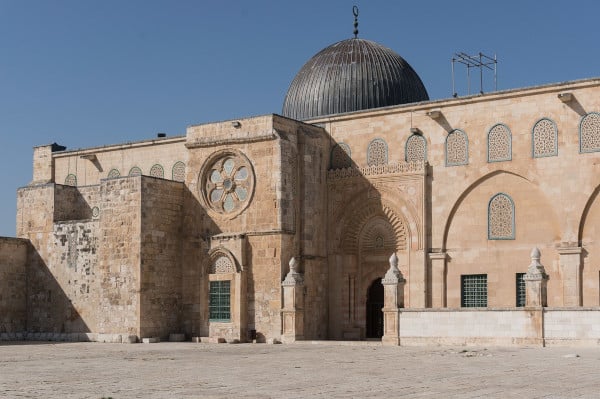
Places like this face a twofold challenge when it comes to fire. Like the Notre-Dame de Paris, churches sometimes lack basic fire safety features. Fire code may make exceptions for older buildings or houses of worship. In turn, churches may opt to not install sprinklers, citing aesthetic or historic concerns (or the high costs of renovating).
But many churches also face the threat of arson. In the United States, the Bureau of Alcohol, Tobacco, Firearms and Explosives (ATF) reported that more than 100 arson fires happen at churches each year. Worse yet, analysis of their data suggests that more than half of all fires at churches were arsons. That’s a strikingly high figure: arson makes up only ten percent of fires in other nonresidential buildings.
Those numbers may somewhat overstate the problem, however. In a 2013 report, the Fire Analysis and Research Division at the National Fire Protection Association (NFPA) found that intentional fires made up only 16 percent of total structure fires in religious and funeral properties from 2007-2011. That makes arson the third-leading cause of fire, behind cooking and heating equipment. Even so, these fires have proven more costly than others, causing a full 25 percent of property damage.
Fire safety experts broach the sensitive subject of alterations to existing churches and historic buildings
NFPA’s 2013 report found that only 12 percent of churches had fire sprinkler systems. And older “legacy” churches—while made from durable dimensional wood and stone—often have high ceilings that let smoke and fire move quickly.
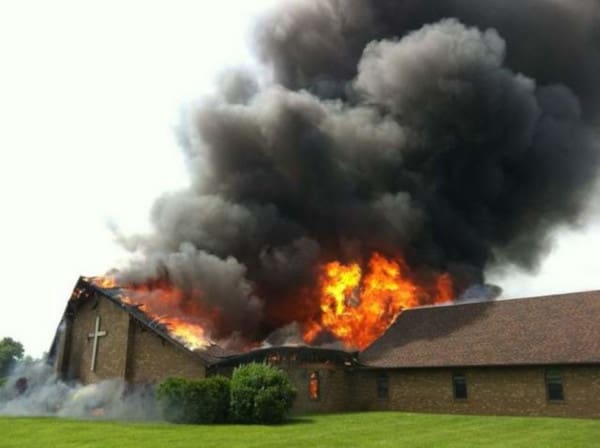
Some local governments have required fire safety improvements in older buildings. Tragic fires in high-rises and gathering places have led to more exacting rules and required retrofits. But renovations can be a delicate subject in religious buildings. In response, NFPA has written two standards for structures like Notre-Dame:
- NFPA 909: Code for the Protection of Cultural Resource Properties—Museums, Libraries and Places of Worship
- NFPA 914: Code for Fire Protection of Historic Structures
These rules provide churches with much-needed latitude. Both standards allow those charged with the structure’s care to embrace performance-based safety measures. Unlike other codes—which tell contractors which materials to use and where they’re required—NFPA 909 and 914 let owners set safety-related goals. In turn, designers figure out how to achieve those goals while leaving sensitive features intact.
Both standards also stress collaboration. NFPA 914 requires those in charge of a building to assemble a team with expertise in preservation, security, and fire protection. In NFPA 909, caretakers decide on an acceptable level of risk, and work with local officials and experts to bring that risk to tolerable levels. Those risks vary—from arson to natural disasters—but the end result is a safer facility and more safety-conscious staff.
Churches answer the call of fire safety
After the fire at Notre-Dame Cathedral, some congregations and elected officials have taken a second look at the problems facing aging churches and landmarks. News outlets from the Detroit Free Press to USA Today have asked if something like the Notre Dame fire could happen in the United States. And Nebraska’s Omaha World-Herald reported on the lack of fire sprinklers in churches throughout Omaha, including the St. Cecilia Cathedral—a church, museum, and art gallery erected more than 100 years ago.
Some good news comes from the International Fire Suppression Alliance (IFSA), a non-profit advocacy group for water-based fire protection. IFSA has compiled an impressive list of churches that have recently survived fires thanks to fire sprinkler systems, including:
- Christ Unity Baptist Church (Modesto, CA), where a church caretaker set seven fires in a basement
- Concord Fortress of Hope Church (Kansas City, Missouri), where a maintenance worker’s attempt to cover up a burglary by setting fire to the building failed
- Lifeway Fellowship Church (Killen, Texas), which survived an electrical fire that began in the middle of the night
Perhaps the most encouraging example comes from the historic Christ Church in Center City, Philadelphia. With a steeple that’s 265 years old—and a building more than 300 years old—it’d be easy for Christ Church to place historic preservation before fire safety.
But over the years, Christ Church has added new layers of fire protection. Today, that protection includes a deluge fire sprinkler system designed to protect the steeple with a torrent of water. In the wake of Notre-Dame, Christ Church reassured residents that the cathedral was fire-safe by testing their sprinklers.
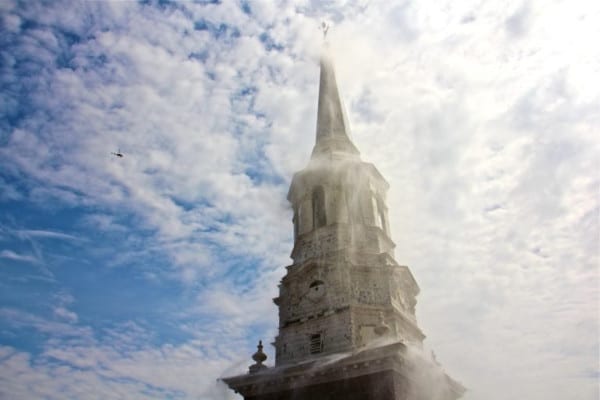
Improvements to houses of worship are sorely needed—and possible
With churches—especially older ones with a deep history—there’s an understandable, if misguided, desire to not fix what isn’t broken. But defects in sprinkler heads are amazingly rare, and the threat of fire all too common. With the flexibility of modern fire codes and the versatility of today’s fire protection technology, parishioners can keep themselves and the places they love intact.
For more information on making existing buildings fire-safe, take a look at these blogs:
- “Why and When the US Retrofits Sprinklers in Existing Buildings.“
- “Retrofitting Fire Sprinklers: What a Large-Scale Project Needs for Success.“
One type of fire sprinkler system—the preaction system—is especially well-suited to both fire safety and historic preservation. Some of these systems prevent spray from sprinkler heads until electronic devices, like heat or smoke detectors, sense a fire in progress. For more, we invite you to read “Fire Sprinkler Systems: History, Types, and Uses” and stay tuned for our upcoming series on preaction systems.
Questions about this article? Looking for resources on making sacred spaces safer? Call us at +1 (888) 361-6662 or email support@qrfs.com.
This blog was originally posted at blog.qrfs.com. Read more at Facebook.com/QuickResponseFireSupply or on Twitter @QuickResponseFS.


